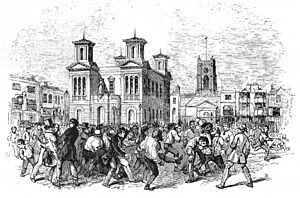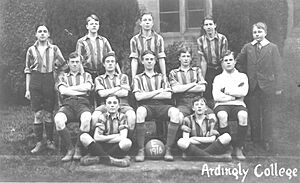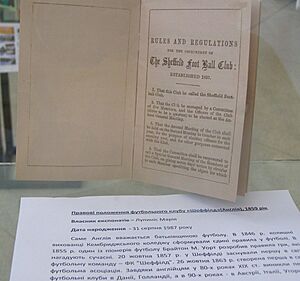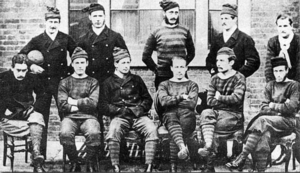History of football in England facts for kids
Football, also known as soccer, has a very long and interesting history in England. It's one of the most popular sports in the world today, but it started out quite differently.
Contents
Early Football Games
Modern football games, like the ones we play today, grew out of older games called "folk football." These were played in England long ago, before big factories and cities existed.
What Was Folk Football Like?
We know more about folk football from the 1700s and 1800s. It was often played by many people over huge areas. Sometimes the goals were as far as three miles apart! For example, in Ashbourne, the goals were very far from each other. In Whitehaven, one goal was a harbor wall and the other was a town wall.
In Derby, about a thousand players might join a game. The main idea was to kick, throw, or carry a ball to a goal. The ball was often a pig's bladder. Sometimes, only kicking was allowed. Even though there were some rules, folk football was very rough. Players often kicked each other's legs, which was called "shinning." This was allowed even if the ball was far away.
Folk football was mostly played in the countryside. Games often happened during country fairs. But things changed when factories and towns grew. People moved from farms to cities. A game that took hours and covered huge areas didn't fit with city life. In 1801, a writer named Joseph Strutt said football was "formerly much in vogue among the common people." Even though he thought it was less popular, many games continued until new rules were made.
Making the Rules (1801 to 1891)
How the British Empire Helped Football Spread
In the 1800s, football started to spread more widely. The British Empire helped a lot. They wanted to use football to teach important values like order and discipline. It was also a way to prepare young men to become workers or soldiers. Football became popular with soldiers and officials in other countries. This helped football spread around the world, sharing British ideas.
Football in England began as a game for richer people. The British Empire helped football grow not just in England, but globally. Early football clubs were formed by important local people. Examples include Darwen and Turton in Lancashire. Football spread internationally through schools. Young men were encouraged to play and start their own clubs after finishing school. Because of the British Empire's influence, some big clubs like AC Milan and Genoa in Italy, and Grasshoppers and Young Boys in Switzerland, have English names.
Football in Public Schools

As the 1800s began, football became important in public schools. It fit well with the idea of "Muscular Christianity," which believed in building strong bodies and good character. Like cricket, football was seen as a sport that built character.
Rugby School was a leader in this. Boys there started playing football around 1800. They were likely inspired by a game played by people in Rugby, Warwickshire, every New Year's Eve. Public schools wanted to make their students tough enough to lead the British Empire. They thought past empires fell because their leaders became weak. At Rugby, students were even encouraged to "hack" (kick other players' legs) to toughen up. This became very important, along with cold showers and long runs. Hacking was a big issue when the game later split into "handling" and "dribbling" versions.
By the 1820s, other public schools made their own football rules. These rules were often just spoken and passed down. Each school, like Eton, Harrow, and Winchester, had its own way of playing.
In 1839, Albert Pell, a former Rugby student, went to Cambridge University. He started organizing football matches there. But because each school had different rules, they had to create a compromise set of rules. By 1843, Eton had rules that allowed players to touch the ball with their hands to control it. But they couldn't run with it or pass it by hand. The first known 11-a-side games happened at Eton, where the "dribbling game" was popular.
In 1845, Rugby School wrote down its football rules. These rules allowed players to carry and pass the ball by hand. These Rugby rules are the earliest known written rules. They were a big step in the creation of Rugby league and Rugby Union.
Eton also started using referees and linesmen, who were called umpires back then. In 1847, Harrow created its own rules, also playing the "dribbling game" like Eton. Winchester had yet another version. The first Cambridge University Rules were written in 1848 by students who were still confused by all the different school rules. This was the first attempt to write down rules for association football (the "dribbling" game), separate from rugby football. Sadly, no copy of the original Cambridge Rules still exists. The main difference was that association football did not allow players to run with the ball in their hands or pass it by hand to a teammate. However, players could still touch and control the ball with their hands.
Sheffield, Cambridge, and FA Rules
In the winter of 1855–56, players from the Sheffield Cricket Club played informal football matches. This helped them stay fit. On October 24, 1857, they officially created Sheffield Football Club. This club is now known as the world's oldest association football club.
On October 21, 1858, at the club's first big meeting, they wrote the Sheffield Rules for their games. Kicking other players' legs ("hacking") was banned. But players could still make a "fair catch" to get a free kick, as long as they didn't hold the ball. A little over a year later, in January 1860, the rules were updated to ban handling the ball completely.
On December 26, 1860, the world's first game between two clubs took place. Sheffield beat the new Hallam F.C. at Hallam's ground, Sandygate Road. In 1862, a team formed in Nottingham is thought to be the start of Notts County. This club was officially formed in December 1864 and is the oldest professional association football club in the world.
In October 1863, a new version of the Cambridge Rules was published. Soon after, on October 26, twelve clubs and schools met in London. Eleven of them agreed to form The Football Association (the FA). Running with the ball in hand was also banned. But players could still make a "fair catch" to get a free kick.
How Rule Changes Affected the Game (1863 to 1891)
In 1874, Charles W. Alcock came up with the term "combination game." This was a style of play based on teamwork and passing the ball, instead of just dribbling it. Early teams known for this style were Royal Engineers A.F.C. (started in 1863) and Glasgow-based Queen's Park F.C. (started in 1867).
Competitive, International, and Professional Football (1871 to 1890)
On July 20, 1871, Charles Alcock, who was the FA secretary, suggested a new idea. He proposed that the FA should create a "Challenge Cup" for all clubs to compete in. This led to the creation of the FA Cup, one of the oldest football competitions.
International football began in 1872. The England national team traveled to Glasgow to play the Scotland national team. This was the first-ever official international match. It was played on November 30, 1872, at Hamilton Crescent in Glasgow. The game ended in a 0–0 tie, and about 4,000 people watched.
Even though English clubs hired professional players, the Scottish Football Association did not allow it. Because of this, many Scottish players moved south to England. At first, the FA tried to stop this with rules about where players lived. But these rules were removed by 1889. Preston North End, the first English team to win both the league Championship and the FA Cup in the same season, had mostly Scottish players. In their first season, they didn't lose any games in the league or the FA Cup. This earned them the nickname "the invincibles."
Samuel Tyzack, a rich miner, and Robert Turnbull, a shipbuilder, helped fund the professional Sunderland team. This team was known as the "team of all talents." Samuel Tyzack sometimes pretended to be a priest when looking for players in Scotland. Sunderland's way of recruiting Scottish players made many Scottish fans angry. In fact, the entire Sunderland team in the 1895 World Championship was made up of Scottish players.
Sunderland's home stadium, Roker Park, was built in 1898. It was designed by Archibald Leitch.
See also




